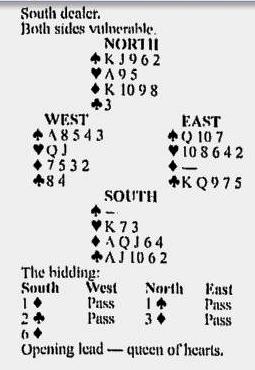Reading Eagle – Jan 17, 2008 by Steve Becker
As the bidding progresses, the rise and fall of one’s values is a phenomenon worthy of close attention. In distributional hands especially their worth may fluctuate startlingly as new Information is gathered from the opponents’ or partner’s holding.
For example. when you first look at today’s South hand you would initially rank it as well above a minimum opening hand. Not only does it contain 15 high-card points, it has an attractive 5-5-3-0 distribution. Point counters might differ as to the exact value of the hand deeming it worth anywhere from 17 to 20 points, depending on which school they came from.
But North’s one spade response should have a depressing effect on the initial evaluation. The spade void is no longer an asset but a liability. In fact. at this point the hand depreciates to only its high card values.
However. when you next bid two clubs and partner jumps to three diamonds the complexion of the hand changes radically. The original value is not only restored, but augmented. Your previous doubt as to whether there was game is more than resolved — so much so that a slam is now a very real possibility. And you should conclude that if North feels that the combined hands will produce 11 tricks, you’re surely entitled to try for 12.
The play of the hand is relatively simple. Only one pitfall has to be avoided. You plan a – straight crossruff to score 12 tricks, but you should cash your two heart tricks very early — before starting the crossruff if you don’t, you’ll wind up with tour arm in a sling after West gets rid of his remaining hearts while you are ruffing clubs in dummy.
After playing the king of hearts, ace of clubs and ace of hearts, you ruff spades and clubs back and forth, finishing with 12 easy tricks. That’s all there is to it.
Esta entrada también está disponible en: Spanish

